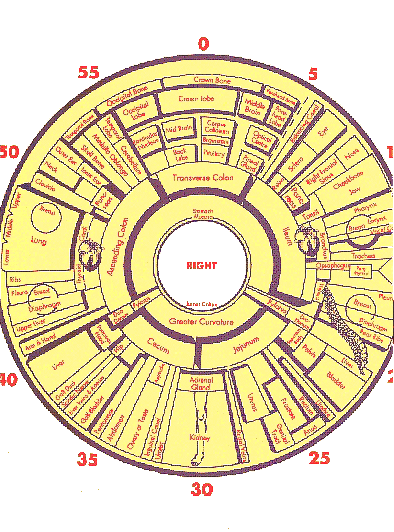December 23rd, 2011 by Steve Novella, M.D. in Quackery Exposed
No Comments »

 There are many medical pseudosciences that persist despite a utter lack of either plausibility or evidence for efficacy. Some practices emerged out of their culture of origin, or out of the prevailing ideas of a pre-scientific age, while others were manufactured out of the imagination of perhaps well-meaning but highly misguided individual practitioners. They were just made up – homeopathy, for example, or subluxation theory.
There are many medical pseudosciences that persist despite a utter lack of either plausibility or evidence for efficacy. Some practices emerged out of their culture of origin, or out of the prevailing ideas of a pre-scientific age, while others were manufactured out of the imagination of perhaps well-meaning but highly misguided individual practitioners. They were just made up – homeopathy, for example, or subluxation theory.
Iridology belongs to this latter category – a system of diagnosis that was invented entirely by Ignatz Peczely, a Hungarian physician who first published his ideas in 1893. The story goes that Peczely as a boy found an owl with a broken leg. At the time he noticed a prominent black stripe in the iris of one eye of the owl. He nursed the bird back to health and then noticed that the black line was gone, replaced by ragged white lines. From this single observation Peczely developed the notion of iridology.
Peczely’s idea was that the iris maps to the rest of the body in some way, and therefore the flecks of color in the iris reflect the state of health of the various body parts. This basic approach to diagnosis or treatment is called the homonculus approach – the idea that one part of the body maps to the rest of the body, including the organ systems. Reflexology, auricular acupuncture, and even straight chiropractic follow this approach.
This is what might have happened next: Read more »
*This blog post was originally published at Science-Based Medicine*
November 29th, 2011 by RyanDuBosar in Research
No Comments »

The idea that the eyes are a window to the soul traces back through history in many forms, but the idea that the eyes might reveal medical secrets didn’t fall far behind the metaphor.
The clues lie on the retina, which reflects the same microvascular changes that might be seen elsewhere in the body from cardiovascular changes and other diseases. The question now is how to associate retinal changes to specific diseases.
To assess potential associations between retinal microvascular changes with disability in performing activities of daily living, researchers conducted a prospective cohort study of 1,487 community-dwelling, disability-free participants in the Cardiovascular Health Study.
The main outcome measure was Read more »
*This blog post was originally published at ACP Internist*
November 23rd, 2011 by Medgadget in News, Research
No Comments »

 We’re another step closer to integrating real time information into our vision. Researchers from the University of Washington and Aalto University Finland have engineered the first prototype of a computerized contact lens on which you can see information updates. They presented their findings today in IOP Publishing’s Journal of Micromechanics and Microengineering.
We’re another step closer to integrating real time information into our vision. Researchers from the University of Washington and Aalto University Finland have engineered the first prototype of a computerized contact lens on which you can see information updates. They presented their findings today in IOP Publishing’s Journal of Micromechanics and Microengineering.
The lens only contained one pixel, but by proving that the concept works without any adverse side effects, they can develop it into lenses with more pixels. This could eventually lead to contact lenses on which you can read your email and catch up on the news. A device like this could also Read more »
*This blog post was originally published at Medgadget*
September 25th, 2011 by KerriSparling in True Stories
No Comments »

Normally, my vision is better than 20/20. (20/15 is mine, which always prompts my eye doctor to say “Oh, you should be a pilot!” and then I laugh my face off because, really, do you know me, lady?) I’m lucky not to wear glasses or contacts at this point in my life, especially considering that everyone else in my family needs a little visual help at this point.
I’m grateful that my vision is excellent most of the time, despite a few diabetic retinopathy issues. But for the last 48 hours, it’s been a little dodgy, and managing diabetes while my eyesight is impaired has been challenging. Yesterday was the worst day for this latest relapse of the ol’ corneal abrasion, so my vision was very limited in the affected eye (and the other eye was swollen in a lovely, compassionate response to its friend’s injury, so basically I look like I’d been tagged in the face with a baseball – twice.).
My Dexcom graph was next-to-impossible to read. Read more »
*This blog post was originally published at Six Until Me.*
October 11th, 2009 by Bongi in Better Health Network, True Stories
No Comments »

 I recently read a post that reminded me of an incident. depending on which side of the eyelid you found yourself that day, it could have been funny…or not.
I recently read a post that reminded me of an incident. depending on which side of the eyelid you found yourself that day, it could have been funny…or not.
I was doing casualty sessions after hours. It was a way of making ends meet while I was specialising, but mostly I just hated it. Anyway one night, between the snotty noses and neurotic parents a patient actually came in with a casualty-worthy complaint. He had a small laceration on his forehead. We decided to glue it together with dermabond because it was so small. I decided to leave it to the sister. After all the unit was full to overflowing with snotty noses and paranoid parents that I was required to work through and get rid of.
After a while the sister came to me. She had terror written all over her face. Read more »
*This blog post was originally published at other things amanzi*
 There are many medical pseudosciences that persist despite a utter lack of either plausibility or evidence for efficacy. Some practices emerged out of their culture of origin, or out of the prevailing ideas of a pre-scientific age, while others were manufactured out of the imagination of perhaps well-meaning but highly misguided individual practitioners. They were just made up – homeopathy, for example, or subluxation theory.
There are many medical pseudosciences that persist despite a utter lack of either plausibility or evidence for efficacy. Some practices emerged out of their culture of origin, or out of the prevailing ideas of a pre-scientific age, while others were manufactured out of the imagination of perhaps well-meaning but highly misguided individual practitioners. They were just made up – homeopathy, for example, or subluxation theory.




 We’re another step closer to integrating real time information into our vision. Researchers from the University of Washington and Aalto University Finland have engineered the first prototype of a computerized contact lens on which you can see information updates. They presented their findings today in IOP Publishing’s Journal of Micromechanics and Microengineering.
We’re another step closer to integrating real time information into our vision. Researchers from the University of Washington and Aalto University Finland have engineered the first prototype of a computerized contact lens on which you can see information updates. They presented their findings today in IOP Publishing’s Journal of Micromechanics and Microengineering.










